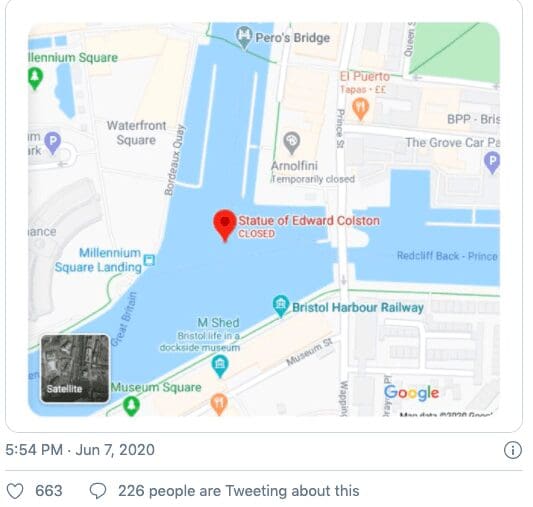
Statue of Edward Colston in the river Avon.
There are many ways to stand.
You can stand up, stand down, stand together, stand with, stand for and stand against. This is of course not an exhaustive list but standing alone is not neutral.
Over the last month we have seen what it means when various publics ‘make a stand’ for what they believe in and how this intentional position might result in action. Amidst the Black Lives Matter protests that swept across the world in the wake of the murder of George Floyd at the hands of Minneapolis Police Officers at the end of May, we see the very much-needed introspection of our cultural institutions. Witnessing the brutality of George Floyd’s death shook the world in a moment while we are still dealing with the Covid-19 pandemic. The call for justice resonated across the world and has made us all, individually and collectively, reflect on our responsibility of being witnesses to such a tragic death.
The voices and chants of grass roots movements have been articulated as audible demands. Who do you stand with? What do you stand for? What do you stand against? How do our institutions reflect what we say we stand for? How can institutions change their statements into actions? What stands in our public spaces and can we uphold public statues as standing for all? The campaign to remove Edward Colston because of his direct involvement as a merchant and slave trader and the fact that Bristol benefitted from this benevolence has long been a bone of contention. Ironically, he was erected as a figure to unite the people of Bristol. Streets and institutions across the UK are named after slave traders and merchants directly benefitting from enslaved labour – while these histories of Britain’s involvement are absent from our national curriculum and even in the places where statues themselves stand. The ongoing grassroots campaigning of various publics has now transformed into action. After the bronze figure of Edward Colston was toppled, rolled down the street and dumped in the river Avon, Sara Wajid the Head of Engagement at the Museum of London mentioned that within 48 hours she saw the removal of another statue of a slave trader Robert Milligan removed amidst cheers. It has been incredible to see that social collective power can shift within the culture of Britain.
The action of an individual also takes strength, to be the one to speak out, to call out, to stand up by standing down. Artist Evan Ifekoya shared a public letter for why they were removing their labour from Goldsmiths University. Taking action and doing the labour needed to ensure that anti-racism policy does not stay at the level of rhetoric is very much needed. What we say we are, what we think we are should also be a reflection of what we do. There is no quick fix or one-line solutions, it is the ongoing, consistent commitment to unlearning, decentering whiteness, dialogic exchange and openness to new ideas that keep cultural institutions relevant.
On July 1st, over 770 colleagues from around the global cultural sector joined Beyond Statements: Taking Action, organised by Association of Art Museum Curators Foundation and Art Fund. Speakers included: Sepake Angiama, Artistic Director, Iniva; Monica O. Montgomery, Cultural Consultant + Independent Curator & Strategic Director, Museum Hue; Sandra Shakespeare, Museum and Heritage Consultant & Co-Founder, Museum Detox; and Sara Wajid, Head of Museum Engagement, Museum of London and Founding member, Museum Detox. They discussed ways that individuals and organisations can enact change to address racial diversity, equity, and inclusive environments in education, programming, curatorial, and other departments.
If you missed the conversation, watch it here: